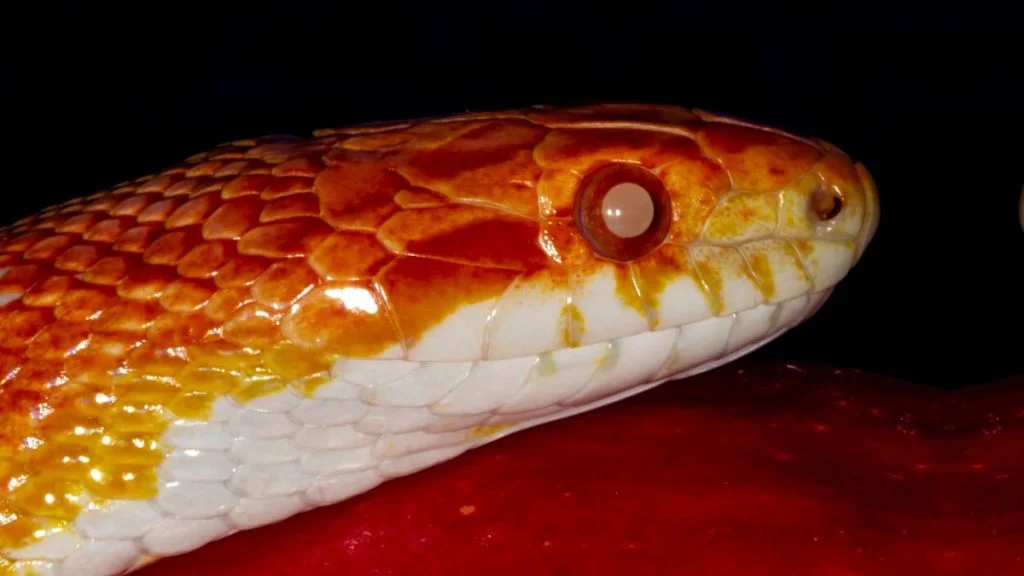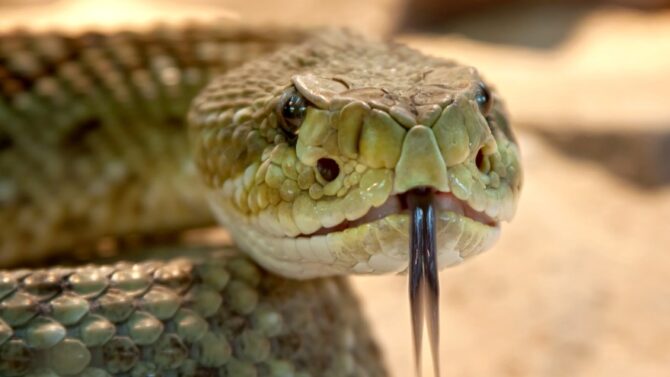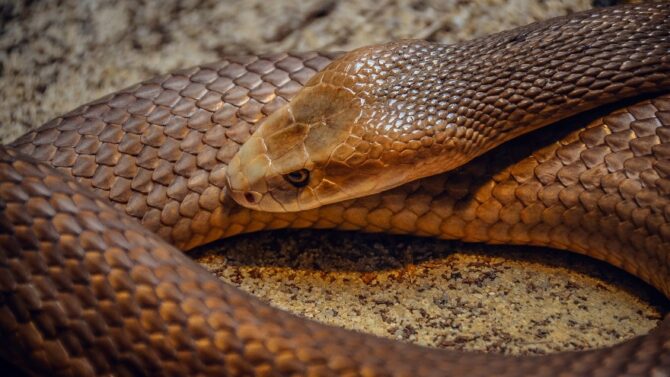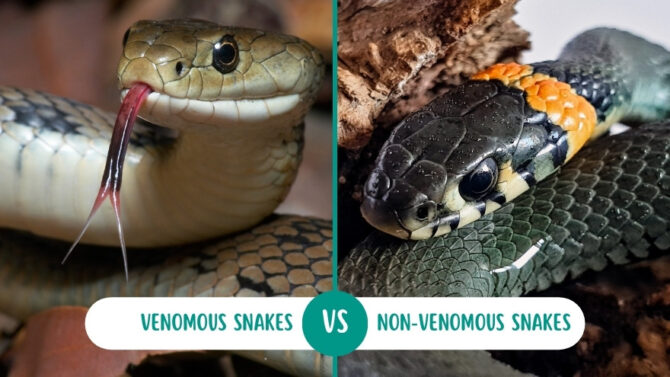Are snakes blind? Can a snake see with its eyes?
There are many stereotypes and myths surrounding snakes. Some have truths in them, while many are embellished with exaggerations.
One such stereotype is that all snakes are blind. Like every stereotype you know, this has some truth in it, but it can’t be accepted as absolute.
Not all snakes are blind, but some species are. Also, snakes generally don’t have the sharp eyesight of eagles and hawks, which fuels the stereotype.
They rely on other senses like smell and vibration. However, many of them see, and can even sharpen their sight when facing danger.
This means that some snake species are blind, but not all of them are.
The remaining parts of this article will explore the snake’s vision, including examples of some species of blind snakes.
How do Snakes See?

Snakes don’t see as humans do, or hawks, or insects, or any other animal. Their eyes are unique and correspond with their environment.
Diurnal snakes see differently from nocturnal snakes. The diurnal snakes can see in detail, and have a filter that sharpens their visions.
Nocturnal snakes, however, have no filter. This is possibly why they are more active at night as they can’t see well during the day.
Nocturnal snakes rely on senses and vibration more than diurnal snakes. Some of them, like vipers, have a heat sensor that helps them navigate the dark.
The heat sensor picks up radiations from a living animal using a membrane in “pit organs”, a hole in the faces of the snakes that have this ability.
The radiation doesn’t make them see completely, but they can detect which living being is close by, especially prey. It may not notice the animal if it is dead.
That said, snakes don’t top the list of strong eyesights in the animal kingdom.
This makes it hard for them to recognize people, and even pet snakes don’t easily recognize their owners.
They use scents, so if you want to own a snake, make sure it associates you with a good scent like food.
Snakes also have some difficulties with seeing color, which we’ll look into next.
Can Snakes See Color?

Some experts believe that snakes can see colors. However, they don’t see colors as humans do.
The primary difference in how humans see colors versus how snakes do lies in the terms “trichromatic” and “dichromatic”.
Simply put, trichromatic animals and humans can see in three primary colors. For humans, that’s blue, red, and green.
Snakes are dichromatic, which means they can see in two primary colors, blue and green. This limits the colors they can see compared to what humans can see.
Being dichromatic has its advantages for snakes, though not so much for humans.
A human with dichromatic eyes is considered ill, but snakes see better than humans in dim-lit areas because of their dichromatic eyes.
To some other experts, snakes see only in black and white. This seems to be consistent with some species, as they have only one cone cell. However, it isn’t true for all snakes.
Are Snakes Blind?
Some snake species are hatched blind, and they have to live depending on all other senses. It all depends on the species.
Some snakes like the boa constrictor have very good eyesight, some have lesser, and then there are the blind ones.
We’ll be looking into 7 species of blind snakes, but first, let’s look into the factors that may lead to blindness in snakes.
Why are Some Snakes Blind?

Scientists point to evolution as a good reason for blindness in some species of snakes.
According to experts, the habitat and lifestyle of these snakes possibly didn’t require the use of light. This could be because most of them lived underground.
Also, the prey of these blind snakes is often small, suggesting that they didn’t need to see the prey before hunting. With smell and heat, they track down prey.
According to evolution, snakes evolved from lizards. Blind snakes developed the senses of smell and not of sight due to their importance.
We can compare that to humans and our evolved ability to communicate because it was necessary to survive.
This can be explained in another way. Organisms that are related develop in similar ways in their embryo, but then changes occur later on.
Blind snakes have eyes as developing embryos, but further development emphasizes on other senses because they are more useful.
This is similar to a human embryo that has tails that then disappear at birth.
The 8 Species of Blind Snake
1. Brahminy Blind Snake
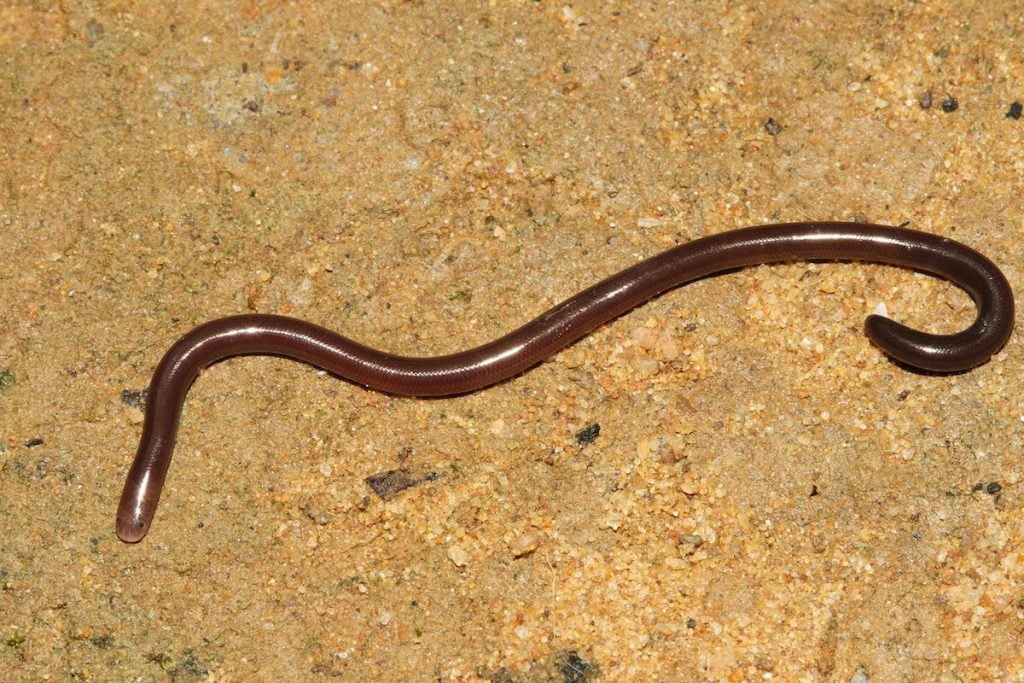
The scientific name of the Brahminy blind snake is the Indotyphlops braminus, and it can be found mainly in Africa and Asia.
However, it has also been introduced in other countries. It is small in size and resembles an earthworm, but differs in that it has scales in place of the earthworm’s segments.
Brahminy lives underground, another quality that makes it similar to earthworms. Its eyes are covered with scales, making it unable to see images.
However, it can detect the intensity of light. This snake species isn’t venomous, but it is a carnivore, and it feeds on the larvae, eggs, and pupa of insects.
2. Long Tailed Blind Snake
The long-tailed blind snake’s scientific name is Ramphotyphlops, and it can be found in Asia and on islands of the pacific ocean.
There are currently 22 species of long-tail blind snakes in existence today, and they live in many habitats. They are longer than the Brahminy but share the same inability to see.
This snake often stays under leaves, in nests of ants and termites, and on fallen logs.
They’re carnivores, feeding on earthworms, alongside the eggs or larvae of insects. They give birth to their young by laying eggs.
3. Palau Blind Snake
This snake can be found in Palau (Pacific Island), and its scientific name is Ramphotyphlops acuticauda.
Not much is known about the Palau Blind Snake, but we can deduct a lot about this species from the Typhlopidae family of blind snakes.
The blind snake family usually lives underground, and thus, does not need the eyes. The Palau blind snake is most likely the same.
These snakes can detect light, and they usually lay eggs.
4. Southern Blind Snake

Two blind snake species bear the blame “Southern blind snake”. The first can only be found in Australia, and its scientific name is Anilios australis.
It lives in some Australian states like New South Wales, Northern Territory, Western Australia, and South Australia.
Though classified as “least concern”, not much is known about this species, possibly due to its limited range.
The second Southern blind snake is endemic to South America and is scientifically termed Rena unguirostris.
The specific countries Rena lives in include Argentina, Bolivia, and Paraguay.
5. Christmas Island Blind Snake
The Christmas Island blind snake lives only on Christmas Island in Australia, from where it got its name.
Its scientific name is Ramphotyphlops exoceoti. “Exoceoti” stands for “flying fish”, given in honor of Navy officers of HMS flying fish, a sailboat.
Unfortunately, the Christmas Island blind snake is endangered. While not yet critical, it is still a cause for concern.
Its survival in the wild is shaky, and it might get extinct if nothing is done.
6. Puerto Rican Coastal Blind Snake
The Puerto Rican coastal blind snake goes by the scientific name Antillotyphlops hypomethes, and it is found in Puerto Rico.
Like a couple of other species on this list, this snake is rare.
Though not under any threat of extinction, not much is known about it except what we know about the blind snake family.
7. Sulcate Blind Snake
The Sulcate blind snake goes by the scientific name Typhlops sulcatus and lives in the Dominican republic. It is classified as “Near threatened.”
8. Richard’s Worm Snake
The Richard’s worm snake species can be found only in the Caribbean.
The British Virgin Islands, the Turks, and Caicos Island, and the United States Virgin Islands are all where Richard’s blind snake can be found.
It was named after either Louis Claude Marie Richard or the son Achille Richards, both of whom are botanists.
How do Blind Snakes Hunt and Explore?
While blindness is a big disability for many other living beings (including dogs, cats, and humans), blind snakes have since adapted to using other senses.
Hence, they don’t seem to be at a disadvantage over their visual impairment.
Some of the methods used are:
Snakes smell with their tongues
This would be surprising for someone hearing this for the first time, but it is no less true. Snakes only use their nostrils to breathe, but all smells are done with the tongue.
This is possible, thanks to Jacobson’s organ which comes with two glands that make them smell.
Vibration
Vibration is another method blind snakes use to explore their environments and find prey.
Snakes often have their heads raised for that reason. Experts advise that you do not pick up snakes by the tail or they’ll consider you as prey.
Heat sensor
Some snakes possess heat sensors that enables them to pick up the radiation that objects and their prey emits.
Are Blind Snakes Less Likely to Live Long?
All other factors aside, blind snakes can live as long as other snakes.
As we explained earlier, blindness isn’t a disability for snakes, but a natural omission, much like humans not having tails.
According to a study done on tiger snakes that lost their sight, snakes still function normally without vision.
They also have defense mechanisms against predators, just the same way they adapted to detecting prey. Some blind snakes use camouflage to hide away from predators.
The venomous kinds protect themselves with the venom. When either method fails, they’re sleek enough to run away.
FAQs
Can snakes see humans?
Most snakes can’t see human beings clearly and may not recognize their owners by sight. They would only recognize their owners with the scent.
Can snakes see and hear?
Many snake species are blind, and quite a few more have poor eyesight, but there are snakes with strong eyes. Snakes generally don’t have ears and eardrums; so, many scientists believe they’re deaf.
Do blind snakes live long?
Blind snakes are capable of living long, even without their sight. They use other senses like smell (with their tongue), vibrations, and heat sensors to move explore their environment and hunt. They also protect themselves from predators.
Wrap Up
Sight isn’t the strongest sense in many snakes, and some don’t possess it at all.
There are many reasons for this, and it is traced down to some evolutionary possibilities.
However, with so many other senses and ways to survive, blind snakes are at no disadvantage.
Check out these interesting articles:
- King Snake Vs Corn Snake: 6 Differences & Similarities
- Milk Snake vs Corn Snake: 8 Differences & Similarities
Featured Image Credit: Sonya Kate Wilson/Getty Images
